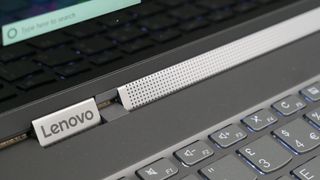Why you can trust TechRadar
In terms of speeds and feeds, we’re talking an Intel Core i5-8250U (a low-power quad-core CPU), 8GB of RAM, which is adequate but perhaps a little stingy, and a 512GB NVMe-capable SSD. Together, that little lot should make for snappy performance, though bear in mind that the integrated graphics that come with the Intel CPU are feeble in gaming terms. Make no mistake about that.
Here's how the Lenovo Yoga C930 performed in our suite of benchmark tests:
3DMark Sky Diver: 4,783; Fire Strike: 1,137; Time Spy: 438
Cinebench CPU: 633 points; Graphics: 55 fps
GeekBench 4: 4,151 (single-core); 14,280 (multi-core)
PCMark 8 (Home Test): 3.441 points
PCMark 8 Battery Life: 9 hours and 32 minutes
Battery Life (TechRadar movie test):13 hours and 10 minutes
While it may be no gaming beast, the laptop certainly doesn’t skimp on connectivity. Both of the USB-C ports are full Thunderbolt 3 ready with display-out support, charging and all the rest. There’s also a full-size USB-A 3.1 port.
The battery meanwhile, is a 60Wh pack that’s claimed to be good for more than 14 hours. If the Yoga can deliver near the claimed longevity, you’re looking at a truly all-day 2-in-1, which would be great.
In terms of actual system performance, it’s mostly as expected – and in a good way. The raw performance of that quad-core Intel chip can’t be denied. Likewise, the 512GB SSD is a decent performer, with 2.5GB/s peak reads and 1GB/s writes, plus reasonable random access performance.
If there is a hitch, it’s a sense of a slightly bloated operating system install. Ostensibly, the Yoga is meant to be set up with less pre-installed software than before, with just Lenovo’s Vantage app consolidating what used to be a suite of Lenovo apps into a unified interface, plus a McAfee anti-malware trial and an MS Office 365 trial loaded from the factory.
However, our review unit is slow to settle down from its initial boot, and loading new apps or installing software sometimes feels sluggish, as though some significant scanning is taking place in the background. Once apps are up and running, the inherent performance of the components is decent. But, further optimization of Lenovo’s operating system setup would be welcome.


Battery life
Battery life is the final piece of the puzzle. In our video playback test, the Yoga clocked up just over 13 hours, which is pretty stellar. PCMark is more demanding, but the overall picture is of excellent battery life that pretty much delivers on the all-day premise.
Only those prone to the most demanding workflows on the move will need to bring the charger along. For everyone else, you should be safe treating the Yoga like a phone: taking it out in the day and charging at night.

Final verdict
As a measure of how far 2-in-1 technology has come, the Lenovo Yoga C930 is a handy yardstick. You give up very little of the pure laptop experience in return for the benefits of tablet functionality.
Yes, if you want the ultimate in slim chassis design and zero bezel displays, a conventional laptop still has an edge. But, the Lenovo Yoga C930 is an awfully nice all rounder. It also has some great stand-out features.
The integrated self-charging stylus, for instance, is a nice touch, albeit probably of only niche appeal. But, everyone will enjoy the fab speaker system, the lush build quality, the vibrant screen and the excellent battery life. The performance from the quad-core CPU is strong, too.
Granted, the Lenovo Yoga C930 isn’t exactly cheap. However, given the overall feature set, functionality and quality, it’s still a strong value proposition.
- 1
- 2
Current page: Performance, battery life, features and verdict
Prev Page Introduction, value, design and displayContributor
Technology and cars. Increasingly the twain shall meet. Which is handy, because Jeremy (Twitter) is addicted to both. Long-time tech journalist, former editor of iCar magazine and incumbent car guru for T3 magazine, Jeremy reckons in-car technology is about to go thermonuclear. No, not exploding cars. That would be silly. And dangerous. But rather an explosive period of unprecedented innovation. Enjoy the ride.

Asus has applied big discounts to these 4K gaming monitors that are perfect for PS5 and Xbox Series X - with some reaching lowest-ever prices

Dead ransomware HelloKitty reanimates in rebrand and releases CD Projekt and Cisco data

Rare's new eco-friendly studio building could potentially power more than 438,000 Xbox Series X consoles
